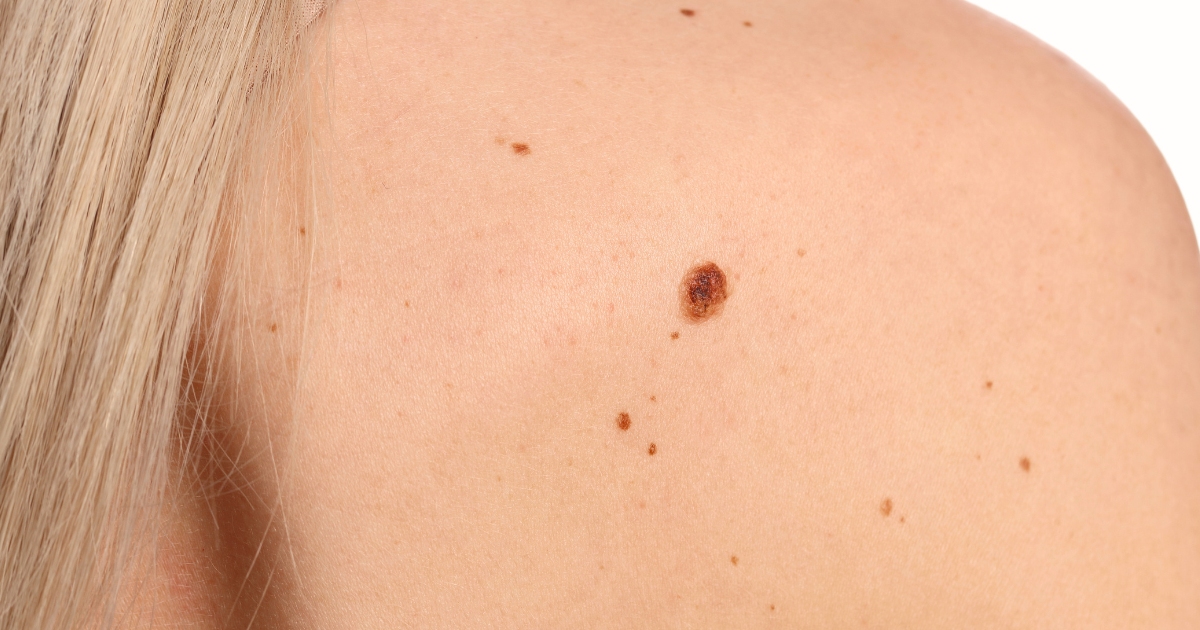What are Skin Lesions?
Skin lesions, in their simplest form, are any abnormality or deviation from the skin’s natural appearance. These can manifest for any manner of reasons, ranging from minor injuries or infections to more severe underlying health conditions. Whilst most of these lesions are benign and pose no significant threat to you, some can be harbingers of more severe medical issues. Hence, we cannot state the importance of understanding and correctly identifying your lesions enough. It is most important to identify the difference between benign and non-benign lesions.
Different Types of Skin Lesions
Benign Lesions
Moles (Nevi)
Moles are small, pigmented spots that can manifest anywhere on the skin. These clusters of pigmented cells are generally harmless. However, it’s essential to monitor them using the ABCDE rule: Asymmetry, Border irregularity, Colour variation, Diameter (larger than 6mm), and Evolving size, shape, or colour. We can have a mole removal service here at Derma Revive
Warts
These are contagious growths caused by the human papillomavirus (HPV). They can appear anywhere but are most commonly found on hands and feet.
Skin tags
Tiny, known as accordions, are benign out-growths often appearing in areas of skin folds like the neck, armpits, or groin. They’re more of a cosmetic concern than a medical one but can cause problems if they rub.
Seborrheic keratoses
These are often brown or black growths with a waxy and slightly elevated appearance. They’re common with age and are non-cancerous.
Cherry Angiomas
Cherry angiomas are small, bright red bumps that appear on the skin due to the clustering of small blood vessels. Common in adults over 30, they’re usually harmless and don’t require treatment unless for cosmetic reasons.
Lipomas
Lipomas are soft, fatty lumps that form under the skin, often on the neck, shoulders, or back. They’re slow-growing, painless, and typically benign, requiring treatment only if they become bothersome to you
Malignant Lesions
Please remember the ABCDE rule when it comes to identifying lesions. If in any doubt at all, consult a doctor.
Basal cell carcinoma
This is the most prevalent form of skin cancer. It often manifests as a white, waxy lump or a brown, scaly patch, especially in areas frequently exposed to the sun.
Squamous cell carcinoma
This cancer is characterised by firm, red nodules or flat lesions with a crusty surface. They often develop in sun-exposed areas but can appear anywhere.
Melanoma
A particularly aggressive form of skin cancer, melanoma can develop anywhere on the body. Monitoring moles for any changes is vital, as melanoma often arises from existing moles.
Inflammatory and Infectious Lesions
Acne
A prevalent skin condition, especially among teenagers, results in pimples, cysts, and nodules. It primarily affects the face, chest, and back.
Psoriasis
This chronic condition results in red, itchy, and scaly patches. It’s an autoimmune disorder, meaning the body’s immune system attacks healthy skin cells.
Eczema (Atopic Dermatitis)
This condition causes the skin to become red, itchy and inflamed. It’s common in children but can occur at any age.
Impetigo
A highly contagious bacterial skin infection, it causes red sores, especially around a child’s nose and mouth.
Common Causes of Skin Lesions
Genetic Factors
Some lesions, like moles and freckles, are hereditary.
Environmental Exposures
Sun exposure
Prolonged sun exposure, including tanning beds, can lead to various skin lesions, including actinic keratosis and skin cancers.
Chemical exposure
Certain chemicals, when they come into contact with the skin, can lead to lesions or allergic reactions.
Infections
Bacterial
Conditions like impetigo.
Viral
Examples include warts and cold sores.
Fungal
Ringworm and athlete’s foot are common fungal skin infections.
Autoimmune Disorders: Conditions like psoriasis and eczema arise when the body’s immune system mistakenly attacks its skin cells.
Diagnosing Skin Lesions
Physical Examination
A visual assessment by a healthcare provider is the first step.
Dermatoscopy
This tool offers a magnified view of the skin, aiding in the identification of malignant lesions.
Skin Biopsy
A biopsy might be called for if the examining practitioner suspects your lesion.
Shave biopsy
Removes a small skin surface piece.
Punch biopsy
Removes a deeper skin layer section.
Excisional biopsy
The entire lesion is surgically removed.
Treatment Options for Skin Lesions
Topical Treatments
Creams and ointments can be used to treat everything from acne to certain skin cancers.
Cryotherapy
A method where lesions, like warts, are frozen off.
Surgical Procedures
Excision
The lesion is surgically removed.
Mohs Surgery
A precise technique to treat skin cancer.
Laser Therapy and Photodynamic Therapy
These light-based treatments can address various skin conditions.
Radiofrequency Energy
Devices utilising RF energy are very useful in removing certain skin lesions.
Medications and Systemic Treatments
Some conditions might require oral medications or treatments that affect the entire body.
Prevention and Self-Care
Regular Skin Checks
Early detection of suspect skin lesions could turn out to be vital to your health.
Sun Protection Measures
No amount of UV exposure is classed as ‘safe’. Even on cloudy days or in the shade, protection is necessary.
Using Sunscreen
Protects against harmful UV rays.
Wearing Protective Clothing
Offers added sun protection.
Maintaining Skin Health
Moisturising
Hydrated skin can prevent certain conditions.
Avoiding Irritants
Avoiding harsh chemicals can prevent skin reactions.
Diet
Diet can play a big part in keeping your skin healthy. Nutrients and vitamins help nourish the skin and give it what it needs to stay in good shape. We don’t need to tell you this but just try to adopt a healthy diet if you want your skin to be healthy.
Final Thoughts on Skin Vigilance
Understanding, identifying, and treating skin lesions early can prevent complications and lead to better health outcomes. Regular skin checks, sun protection, and proper skin care are paramount. When in doubt, always consult an expert.

